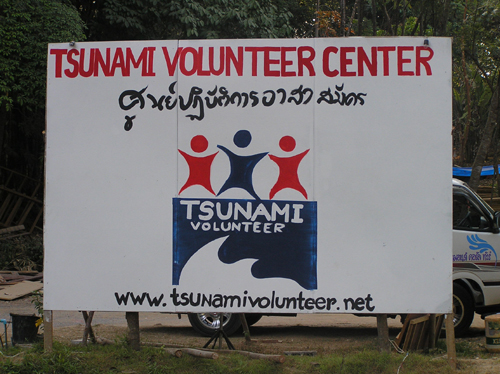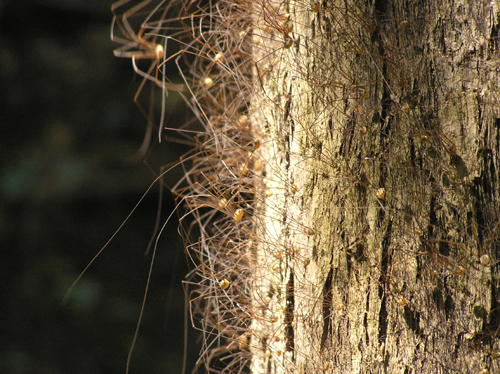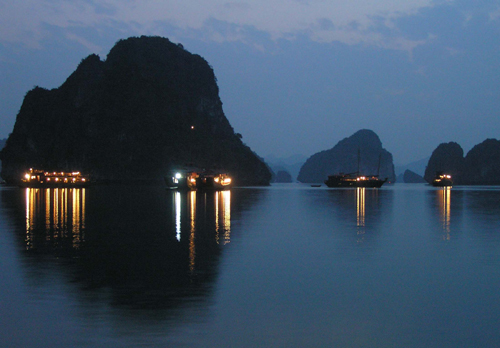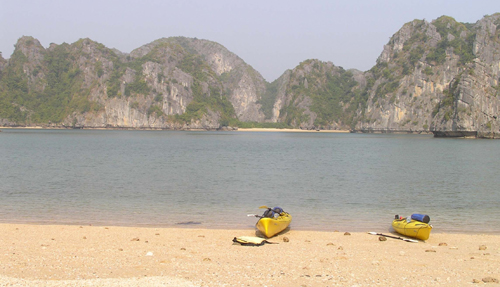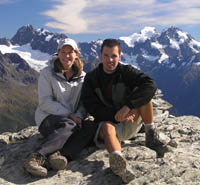Well, you asked for it, here it is. Many have written with questions regarding our day-to-day experiences on this trip. The mundane, everyday, and ordinary experiences. You want to know the basics of Third World traveling life? Ok, here you go.
1. Language: If you haven’t been here, you may be surprised to learn the far-reaching extent of the English language. We are constantly amazed at the extent and quality of spoken English. We always try to learn some of the local language for every country we visit, but it usually isn’t necessary for daily communication. Typically, we learn the very basics (hello, thank you, how much…etc.), but with the exception of China and Tibet, these phrases serve only as nice formalities. Most people we meet speak passable English; many are perfectly fluent. Take Poun, our favorite waiter in Cambodia. He spoke perfect English with a lovely British accent. In fact, we were betting on the number of years he had studied in London when he told us that he had never left Cambodia. Or, consider the man we met in a Vietnamese train station who was fluent in Vietnamese, English, Japanese, French, German, Spanish, and Laotian, and had passable Mandarin Chinese and Norwegian. As Americans who are fluent in no other language, we are damn impressed. When meeting local villagers, however, it is a different story. Here, communication breaks down to little more than facial expressions, hand motions, and breaking out the phrasebook to have a bare bones “conversation” about what your name is, where you are from, your family, etc. These interactions have been some of our most rewarding travel experiences. The hard part is that the written phrases in the phrasebook are not too helpful when the villager you are with has never learned to read.
2. Local Food: The take home message here is that the food is usually great. Not just good, but really and truly great. Yes, there are some really unfortunate meals, but far more often we are thrilled with the food. All of our meals are in restaurants or street food stalls (imagine eating out for more than four months straight). We always try to eat whatever the local food may be. In India it was almost always vegetarian, cheap, and mind-bogglingly delicious. In China it was typically fried vegetables and rice (although meat was available for the brave). Sri-Lanka was hit or miss, but when you hit it, the food was downright sensuous. Cambodian food is wonderful, and Thai food is, of course, amazing. Restaurants run the gamut from small hole-in-the-wall places to (on a rare special occasion) fancy hotel restaurants. In addition to the differences in food, different countries have different style restaurants. In Tibet, most of our meals were eaten huddled around a yak-dung stove in a semi-dark and smoky room. In India, we often ate vegetarian thali at big tables with dozens of locals. In Sri Lanka, we ate many of our meals on the pristine sand of a perfect beach. In Laos, we lounged on pillows to watch Hollywood movies and episodes of "Friends." Nearly every place we have been has had a proliferation of dirt-cheap food stalls. Some you wouldn’t touch for all the money in the world, while others serve absolutely delicious food for mere pennies. It’s a case-by-case decision; you can usually tell which ones are good and safe.
3. Western Food: It is ubiquitous. Except for some of the most remote parts of Tibet, not a day has gone by without an opportunity for us to eat pizza, spaghetti, pancakes, french fries…etc. Depending on your view, this is either a sad-commentary on the effect of Western travelers on local culture, or a godsend. About 90 percent of the time we are in the former camp, but every so often we break down. Although Western food options are common, there are a few things we miss: Lynn craves fresh cold milk, and I long for a good glass of real orange juice.
4. Western Products: Globalization is a frightening thing. I can’t remember a restaurant that didn’t serve Coke, Sprite, or some other American soft drink. We have seen McDonalds, KFC, Subway, Pizza Hut, Au Bon Pain, Burger King, and a myriad of other chains (albeit, most of these were exclusively in Bangkok). These franchises haven’t been that common in our travels, but every time we see one we are reminded how small the world has become.
5. Accommodation: We typically stay in small guesthouses. These can differ dramatically, and price is not always indicative of quality. We have stayed in really nice places for less than $10 a night. In Hong Kong, we stayed in a clean, uninteresting, and truly miniscule room for $34 a night. In most of Asia, $34 is a fortune. The nicest hotel we have had on this trip was in Udaipur, India for $14.49. At the other end of the spectrum, we paid $3.61 to spend a night on a dirt-floor in a school near Mount Everest in Tibet. The windowpanes were broken (i.e., it was freezing cold), the "blankets" were yak hides, and halfway through the night, one of the metal bedposts sank into the dirt floor forcing us to hang on or fall out of bed. When the sun finally came up, it was below freezing
inside our room.
6. Bathrooms: Bathrooms in Asia run the gamut. Many bathrooms are western-style, but squat toilets and even outhouses are not uncommon in some countries. With hotel rooms and their bathrooms, you get what you pay for. More expensive rooms have attached baths, but many of the cheaper rooms do not. Cleanliness runs the gamut too. We have seen bathrooms that you would never consider entering, and others that are sleek, modern, and perfectly spotless. The low points are the Shanti Lodge in Agra, India, a bathroom that quite possibly has never been cleaned in the decades since the hotel was built, and Rongphu Monastery near Everest Base Camp, where the hole-in-the-floor outhouse had overflowed up through the hole and onto the floor (thankfully, it was so cold everything was frozen solid). The gauge of a good bathroom is whether it has toilet paper (bring your own), running water (50-50), soap (uncommon), and a way to dry your hands (extremely rare).
7. Getting Around: We have a couple of rules regarding third-world travel. (1) We never get on the back of a motorcycle; and (2) we avoid catching a ride in any three- or four-wheeled vehicle if possible. The fact of the matter is that driving conditions in Asia are certifiably insane. The roads are horrible, and filled with animals, bicyclists, vendors, pedestrians, potholes, and gobs of other cars, motorcycles, trucks, and busses, all in various states of disrepair. The drivers are no better - passing around blind corners, driving at night without headlights (they think it saves gasoline), and ignoring road rules are the norm. Also, for some reason, nearly every car we have seen in Asia has had its seatbelts removed. Thankfully, Asia has a wonderful system of trains, which we take as often as possible.
8. Laundry: Nearly all of the guesthouses we have been to in Asia offer one-day laundry service at a very affordable price. In some countries, this depends on the weather, as it takes longer to dry clothes when it is raining. We often take advantage of this amenity, but occasionally we end up doing laundry in a bathroom sink. Either way, our clothes get cleaned as often as we like.
9. Travel Day: When we are traveling to a new location, our day typically starts in a train station (night trains are great). Depending on the location, we either walk or take a taxi or tuk tuk (small three-wheeled autorickshaw -- common is Asia) from the train station to an area of guesthouses we have chosen from the guidebook. Upon arrival at the first guesthouse, we inquire to see if there is a room available, and if so, we go look at it. If the room is ok, we negotiate a price. If there is no availability, if the room isn’t acceptable, or if we can’t agree on a price, we head down the street to the next guesthouse and repeat the process. Most of the time, we secure a room quickly, but sometimes this can take several tries.
10. Bargaining: Nearly every purchase we make is subject to negotiation. In China, bargaining is a much-loved pastime enjoyed by all. Each side keeps a smiling face and they like to draw it out as long as possible, taking great pleasure in the giving and receiving of each offer. In Southeast Asia, on the other hand, bargaining is merely a gesture. Simply pausing a bit before agreeing to buy will often cause the vendor to come down to the "real" price almost immediately. In areas that have seen a lot of tourist volume, prices tend to be massively inflated and shrewd bargaining is required. You never have to worry about buying something for too little, because a vendor will never sell without some profit. At the same time, as a westerner, rich by local standards, the goal is not to get the cheapest price, but to find a price that makes both sides happy.
11. Touts: Touts are folks who have found a way to make a living by convincing travelers to visit a certain shop, guesthouse, or restaurant, typically owned by a friend or family member, for which they receive a commission. Far and away, the touts were most aggressive in India. At the train station in Jaipur, for example, the touts swarmed so aggressively that we actually needed to get assistance from a local policeman. In preparation for touts, we make a habit of studying a map and compass before disembarking so we can avoid them by striding confidently away in a direction far from other travelers. In less traveled areas, touts are a rarity.
12. The Bible: There is but one sacred book among backpackers: The Lonely Planet guidebook. We too carry a copy pertaining to (nearly) every country we visit. This book is worth its weight in gold when it supplies you with a much-needed map, points out something of interest well off the beaten track, or simply tells you what the going rate is for a tuk-tuk around the city. But the book can also miss the mark completely. We believe this is a function of its extreme popularity: once an establishment is listed favorably in "the book," it’s economic future is secured regardless of service. We therefore have gotten into the habit of staying at places specifically not listed in the book, and have thoroughly enjoyed departing from the backpacker circus.
Every country is unique. Customs, food, and culture differ dramatically from China to India to Vietnam, and these variations weave an amazing tapestry of human life. Nevertheless, we have come to the striking realization that people around the globe have more similarities than differences. Despite our many peculiarities, folks the world over are tied by a common human bond. We are, as they say in Asia, "same same, but different."

